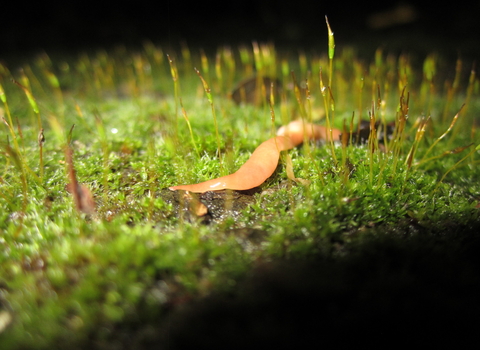Australian flatworms (Australoplana sanguinea) are an invasive species originally from Australia. Although they have been recorded in the UK since 1981, and have been long-term invasive species in Guernsey and Jersey too, they were only recorded in Alderney for the first time in 2023.
The flatworms can be identified by their orange-pink colouration and are 20 – 80 mm long and 2 – 5 mm wide. They are active year-round, but tend to prefer moist soil meaning they are often hardest to find in summer. For tips on identifying Australian flatworms see the resources below.
Why we are concerned
Australian flatworms' diet consists of earthworms, and the presence of the invasive flatworms on Alderney is concerning both for the status of our native earthworms, the species dependent on them (including small mammals and birds), and the ecosystem functions that earthworms provide.
Earthworms are often referred to as 'ecosystem engineers' because their presence modifies our soil's physical, chemical and biological properties. They are decomposers, helping release nutrients in dead organic material, and their burrowing increases the availability of these nutrients to plants, along with better water infiltration and improved soil aeration.
Increased earthworm predation by the invasive flatworms is therefore concerning for the future fertility and health of Alderney's soils, and could have negative impacts on growers across the island.
What you can do
We currently don't know how widespread the flatworms are across the island. You can help by reporting any sightings using this form or by using the iRecord smartphone app (available for Apple and Android).
The flatworms are found in gardens, plant nurseries, parks, moorland, wasteland, pasture and arable land. They are typically found in moist soil, so it's worthwhile looking in the leaf litter and under non-porous material like paving slabs, plant pots or tarpaulins for them.
You can also help prevent the spread of the flatworms by:
- Checking soil around new plants before planting, especially around the root ball and inside pots.
- Checking any gardening or farmyard equipment for flatworms before using it or moving it between sites.
- Not giving or receiving plants or reusing topsoil from areas known to be infested, including between infested plots or beds in allotments and gardens.
- If you feel comfortable doing so, killing any Australian flatworms found by immersing them in any of: salt water, vinegar, alcohol, or fresh water in a sealed container. You can leave this container for a few hours and then dispose of the liquid without further precaution. Be careful to wear gloves if you do this, because some people may be sensitive to flatworm mucus.
- Not cutting flatworms in two or trying to squish them. These worms reproduce by fission (splitting and regenerating into two separate worms), and cutting them in two may just create two worms.
- Treating any infected plant pots by immersing the whole pot (above the root ball) in water >30 °C for 40 minutes.
For further advice on the Australian flatworm, please contact us, visit our Wildlife Information Centre on Victoria Street, or see the resources below.
Resources
Please note that the Alderney Wildlife Trust is not responsible for the content of external sites. Resources from Dr. Hugh Jones are shared with permission.
Factsheets
- Dr Hugh Jones's factsheet on Australian flatworms
- Invasive species Northern Ireland factsheet on Australian flatworms
- Buglife guide to non-native UK land flatworms
More on flatworms:
- GB Non-native Species Secretariat ID sheets
- Dr Hugh Jones's extension for additional flatworms found between 2005 and 2023 in the UK

